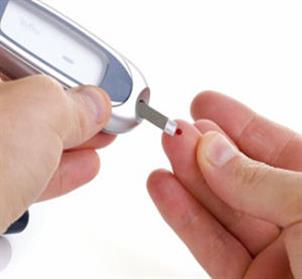

DIABETES MELLITUS
Studies have proven that South Asians (people with roots in India, Pakistan, Bhutan, Nepal, Sri Lanka, Bangladesh, Maldives), people from Mexico and Native Americans (Red Indians) have an increased chance of developing diabetes mellitus (type 2).
Normally, glucose in the body is regulated by the hormone insulin. Glucose comes from carbohydrate present in our diet. The hormone insulin is made in the pancreas, also called pancreas and is located behind the stomach. If there is too little insulin, the cells in our body cannot use up the glucose from the food, causing the glucose levels in the blood will rise. High glucose levels over an extended period can cause damage to the blood vessels. Diabetes can lead to various diseases in the long term as a result of reduced functioning of blood vessels and nerves. This is what happens in people who suffer from diabetes mellitus. A recent Swedish study found that depression, lack of sleep and persistent fatigue in men increases the risk of diabetes mellitus.
Normally, glucose in the body is regulated by the hormone insulin. Glucose comes from carbohydrate present in our diet. The hormone insulin is made in the pancreas, also called pancreas and is located behind the stomach. If there is too little insulin, the cells in our body cannot use up the glucose from the food, causing the glucose levels in the blood will rise. High glucose levels over an extended period can cause damage to the blood vessels. Diabetes can lead to various diseases in the long term as a result of reduced functioning of blood vessels and nerves. This is what happens in people who suffer from diabetes mellitus. A recent Swedish study found that depression, lack of sleep and persistent fatigue in men increases the risk of diabetes mellitus.

Copyright © 2013 All rights reserved. Dietician/Nutritionist Khan - Sitemap
WebDen Website Design en Hosting - Website ontwerp door: www.designer-dragonfly.nl
WebDen Website Design en Hosting - Website ontwerp door: www.designer-dragonfly.nl


Nutritional advice in diabetes mellitus requires knowledge and expertise.
Important objectives of the diabetes diet are:
• achieving and maintaining a normal blood glucose level-
• reaching a stable situation, without hyperglycemia and hypoglycemia
• normalizing the blood glucose levels
• preventing and, if necessary, fight hypertension (high blood pressure)
• if necessary, weight-lose and normalize body weight
• preventing and/or delaying related diseases such a diabetes mellitus nephropathy, retinopathy, neuropathy, diabetic foot,
cardiovascular disorders
• The improvement of health of the patient
• Good motivation of the patient and encouraging the general well-being.
With a diabetes diet, the total amount of fat, especially saturated fat is limited. In addition, a steady supply of carbohydrates is
essential to normalize blood glucose levels. This means an even distribution of food (carbohydrates) in small portions throughout the
day. A diabetes diet should be high in fibre because it plays a favourable role in diabetes mellitus.
A good balance between carbohydrates and sugars is essential and requires self-monitoring to ensure optimal blood glucose values. It
is advisable to be careful with the use of alcoholic beverages. A glass of beer for example can raise the blood glucose levels by the
presence of carbohydrates in the beer and later the values drop due to the alcohol in the beer.
During illness such as vomiting and nausea one may need carbohydrates in liquid form. It is important to eat regular and small
portions. Diabetic Muslim patients should not fast.
Alcohol in diabetes mellitus
People who have diabetes mellitus and who are obesity and/or have high blood pressure, are advised to reduce alcohol consumption.
It is important to monitor the blood glucose levels when drinking alcoholic beverages. The effect is highest 30-90 minutes after
alcohol consumption. The chance of hypoglycemia is greater when the alcohol is consumed without a meal.








Dietary recommendations in diabetes mellitus
Nutrition in diabetes mellitus is an essential part of treatment. When someone has diabetes, that does not mean that he/she must follow a strict diet. People with diabetes should get individual nutritional advice. A dietary advice is in principle given by the dietitian and is important in the treatment. Whether or not medication is being used, the foods you consume and your eating patterns are of particularly high impact on your blood sugar level. The purpose of the diabetes treatment to regulation the blood. The values should be approximately the same as someone who does not have diabetes. To achieve this nutrition plays a very important role in particular the frequency of food intake.
Diabetes patients have a greater risk of heart disease. Therefore, from a preventive point of view one needs to avoid butter, margarine, whole milk and milk products, full-fat cheese, fatty meats, and cold meats, sweet and savoury snacks, chocolate, chips, pretzels etc. Increase consumption of olive oil, garlic, fish, nuts, fruits and vegetables. A daily intake of 25 grams of fish such as mackerel, salmon, cod, herring, eel, flounder, whiting, etc., can significantly reduce the risk of heart diseases. More use of fresh fruits and vegetables promotes the intake of antioxidants. Extensive use of garlic would thin the blood. Starchy foods such as rice, roti, potato, cassava, pasta and breakfast cereals are healthy and naturally low in fat.
Fibres are indigestible carbohydrates in plant food and occur mainly in whole grain products, raw vegetables fruit with skin and legumes. Fibre-rich products like dahl, whole wheat bread, whole wheat pasta (macaroni, spaghetti, noodles), whole grain rice (brown rice, red rice vita), raw vegetables, whole grain cereals (oatmeal, all-bran with 43% fibre) are especially helpful in preventing constipation. Dietary fiber makes the food last longer in the stomach allowing for a gradual blood glucose level. A diet rich in red meat, cold meats, full-fat milk products and high-energy foods poor in micronutrients, constitutes a risk factor.
Nutrition in diabetes mellitus is an essential part of treatment. When someone has diabetes, that does not mean that he/she must follow a strict diet. People with diabetes should get individual nutritional advice. A dietary advice is in principle given by the dietitian and is important in the treatment. Whether or not medication is being used, the foods you consume and your eating patterns are of particularly high impact on your blood sugar level. The purpose of the diabetes treatment to regulation the blood. The values should be approximately the same as someone who does not have diabetes. To achieve this nutrition plays a very important role in particular the frequency of food intake.
Diabetes patients have a greater risk of heart disease. Therefore, from a preventive point of view one needs to avoid butter, margarine, whole milk and milk products, full-fat cheese, fatty meats, and cold meats, sweet and savoury snacks, chocolate, chips, pretzels etc. Increase consumption of olive oil, garlic, fish, nuts, fruits and vegetables. A daily intake of 25 grams of fish such as mackerel, salmon, cod, herring, eel, flounder, whiting, etc., can significantly reduce the risk of heart diseases. More use of fresh fruits and vegetables promotes the intake of antioxidants. Extensive use of garlic would thin the blood. Starchy foods such as rice, roti, potato, cassava, pasta and breakfast cereals are healthy and naturally low in fat.
Fibres are indigestible carbohydrates in plant food and occur mainly in whole grain products, raw vegetables fruit with skin and legumes. Fibre-rich products like dahl, whole wheat bread, whole wheat pasta (macaroni, spaghetti, noodles), whole grain rice (brown rice, red rice vita), raw vegetables, whole grain cereals (oatmeal, all-bran with 43% fibre) are especially helpful in preventing constipation. Dietary fiber makes the food last longer in the stomach allowing for a gradual blood glucose level. A diet rich in red meat, cold meats, full-fat milk products and high-energy foods poor in micronutrients, constitutes a risk factor.
In the late 19th century two German scientists discovered that the pancreas creates a substance in which glucose is removed from the blood. In 1921 two Canadian scientists studied this substance and named it "insulin". In 1922, insulin was used as medicine against diabetes mellitus for the first time. Diabetes mellitus is a chronic metabolic disease. It is a syndrome in which disturbance in the metabolism of carbohydrates, fats and proteins occurs by a deficiency of insulin (a hormone made in the beta cells of pancreas which regulates the blood sugar).
Mellitus is the Latin name for "honey sweet". Traditionally, one uses the name diabetes, because the taste of the urine of these patients was sweet. In former times "taste" tests were carried out to determine whether someone had diabetes. Type 2 Diabetes is one of the Western diseases in the world. A epidemiological increase in type 2 diabetes mellitus threatens public health in wealthy countries. In 2000, the number of people with diabetes mellitus worldwide was 177 million; in 1985 there were still "only" 30 million. This number will be up to 300 million in 2025. The increase in diabetics will above all be prominent in the Western countries due to increasing obesity, the increase in aging population and the increasing lack of exercise.
































